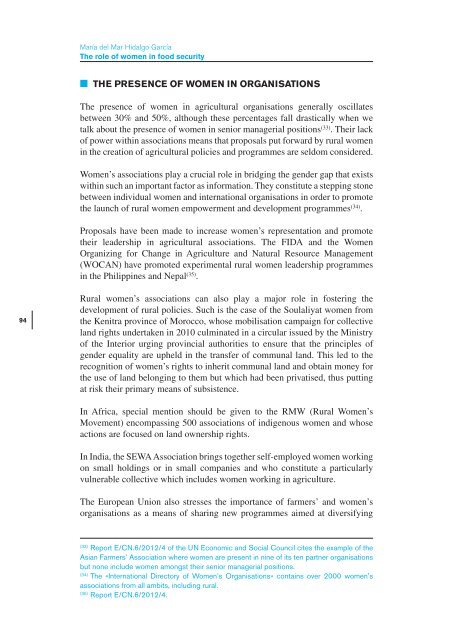Food security and global security - IEEE
Food security and global security - IEEE
Food security and global security - IEEE
- No tags were found...
Create successful ePaper yourself
Turn your PDF publications into a flip-book with our unique Google optimized e-Paper software.
María del Mar Hidalgo GarcíaThe role of women in food <strong>security</strong>■■THE PRESENCE OF WOMEN IN ORGANISATIONSThe presence of women in agricultural organisations generally oscillatesbetween 30% <strong>and</strong> 50%, although these percentages fall drastically when wetalk about the presence of women in senior managerial positions (33) . Their lackof power within associations means that proposals put forward by rural womenin the creation of agricultural policies <strong>and</strong> programmes are seldom considered.Women’s associations play a crucial role in bridging the gender gap that existswithin such an important factor as information. They constitute a stepping stonebetween individual women <strong>and</strong> international organisations in order to promotethe launch of rural women empowerment <strong>and</strong> development programmes (34) .Proposals have been made to increase women’s representation <strong>and</strong> promotetheir leadership in agricultural associations. The FIDA <strong>and</strong> the WomenOrganizing for Change in Agriculture <strong>and</strong> Natural Resource Management(WOCAN) have promoted experimental rural women leadership programmesin the Philippines <strong>and</strong> Nepal (35) .94Rural women’s associations can also play a major role in fostering thedevelopment of rural policies. Such is the case of the Soulaliyat women fromthe Kenitra province of Morocco, whose mobilisation campaign for collectivel<strong>and</strong> rights undertaken in 2010 culminated in a circular issued by the Ministryof the Interior urging provincial authorities to ensure that the principles ofgender equality are upheld in the transfer of communal l<strong>and</strong>. This led to therecognition of women’s rights to inherit communal l<strong>and</strong> <strong>and</strong> obtain money forthe use of l<strong>and</strong> belonging to them but which had been privatised, thus puttingat risk their primary means of subsistence.In Africa, special mention should be given to the RMW (Rural Women’sMovement) encompassing 500 associations of indigenous women <strong>and</strong> whoseactions are focused on l<strong>and</strong> ownership rights.In India, the SEWA Association brings together self-employed women workingon small holdings or in small companies <strong>and</strong> who constitute a particularlyvulnerable collective which includes women working in agriculture.The European Union also stresses the importance of farmers’ <strong>and</strong> women’sorganisations as a means of sharing new programmes aimed at diversifying(33)Report E/CN.6/2012/4 of the UN Economic <strong>and</strong> Social Council cites the example of theAsian Farmers’ Association where women are present in nine of its ten partner organisationsbut none include women amongst their senior managerial positions.(34)The «International Directory of Women’s Organisations» contains over 2000 women’sassociations from all ambits, including rural.(35)Report E/CN.6/2012/4.
















